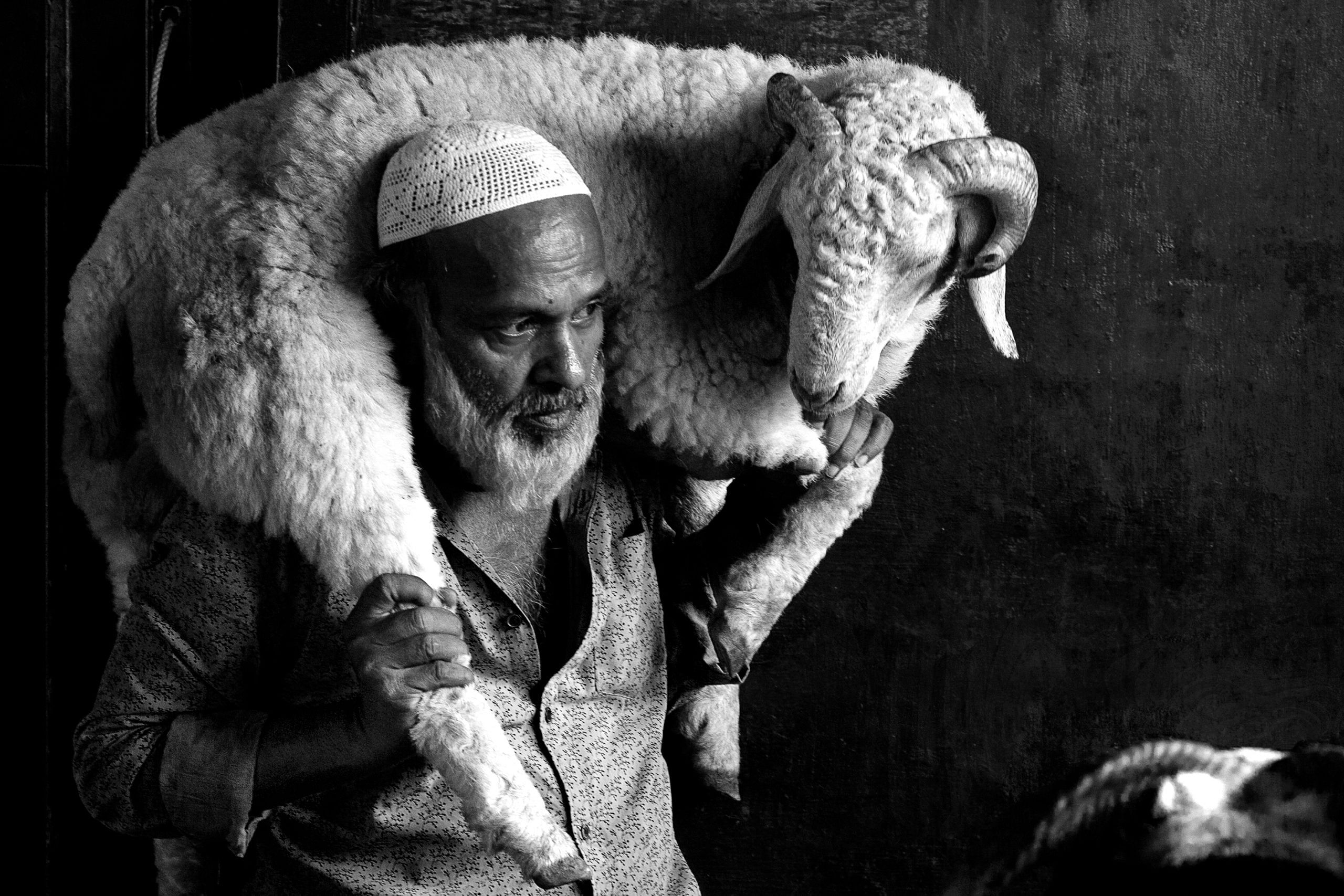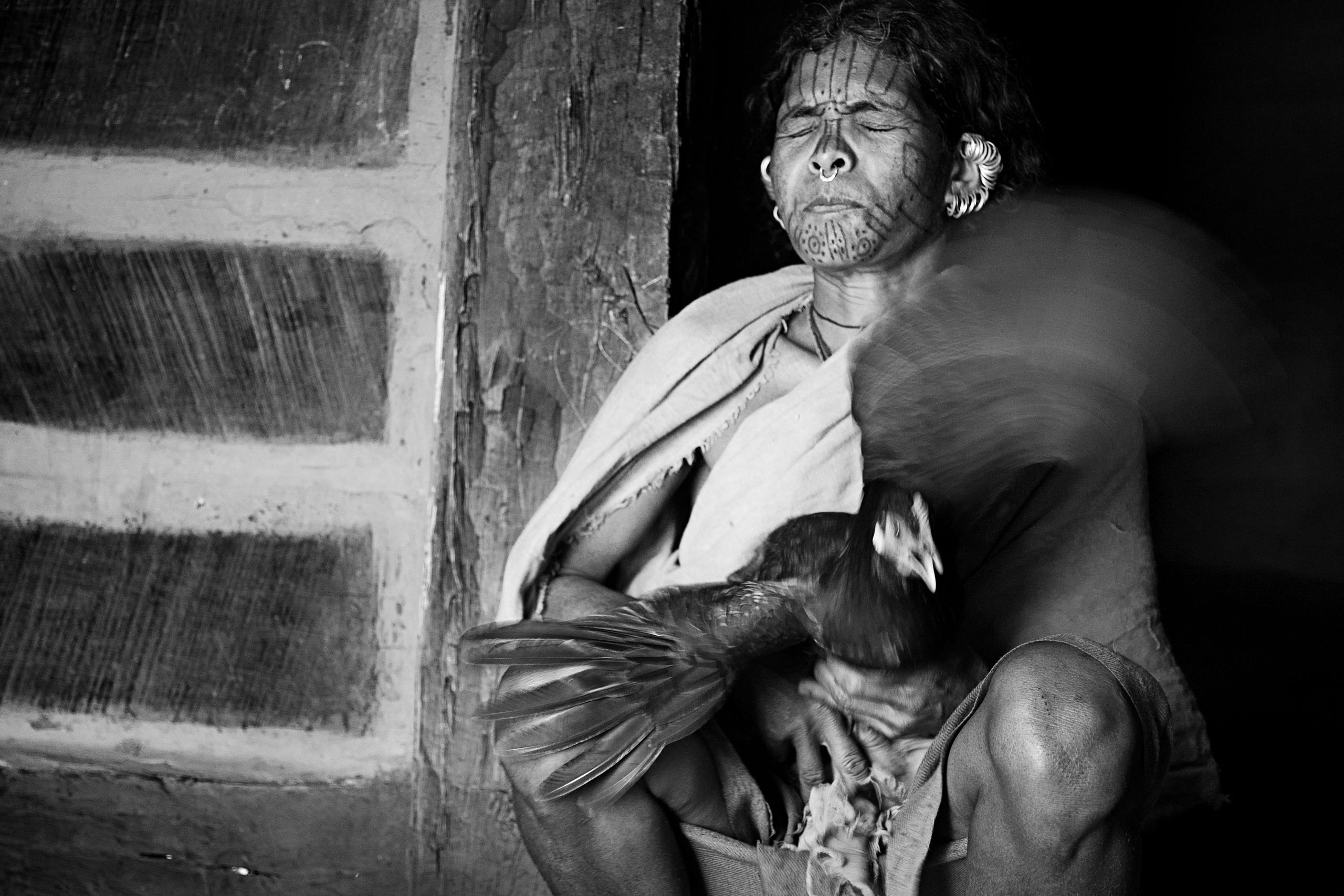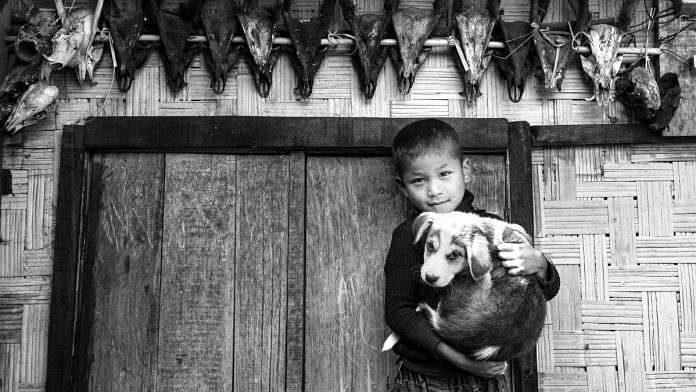Processed goat heads lie on the counter. They are for sale. For many, meat markets are a culinary taboo. But even among them, some bazaars are completely out of bounds—this offal market, for example, is one. And the people who look after it—the lowest in the pecking order.
A young boy cuddles his dog. His love for the animal is evident from the way he holds it close. Does the hunter’s son, who nurtures animals, see the irony of the situation? It’s left to the viewer to decide.
These photographs, which are part of Bangalore-based Asha Thadani’s work, offer a glimpse into India’s socio-cultural ethos and how it revolves around “using and abusing power to disadvantage those we outrank.” She explores her theory through a series of photographs documenting the relationship of Indians with their animals and how it has changed through the years.
The catalogue, titled Interbeing, is on exhibit at Mumbai’s National Centre for Performing Arts from 11 to 21 August as part of the institution’s celebrations marking 75 years of India’s Independence.
“The human-animal equation is a political idea. The man and animal engagement is best perceived and understood through the premise of power,” Thadani tells ThePrint.
“India, where the presence of animals is so embedded in our social, cultural, religious and political thought, practice and dialogue, offers a range of possibilities to convey this fascinating story,” she adds.

Also Read: Tipu Sultan is hot button in India’s culture war. New exhibition adds East India Company to it
‘-isms convey our attitudes’
Thadani, who started her career in photography in 1996, says she is an intentional photographer and likes to plan and research her assignments before she whips out her camera.
She started shooting for Interbeing in 2010 on her slow journeys across Tamil Nadu, Karnataka, Kerala, Madhya Pradesh, Rajasthan, Odisha, Bihar, Nagaland and Manipur, among several other Indian states.
The exhibition of 45 photographs—all in grayscale—puts forth the incongruities in Indian culture in relation to the many political ‘-isms’ of today. “The food chain as a political construct runs through the series. Ideas such as speciesism, anthropomorphism, ecofeminism, animalism, vegetarianism and spiritualism convey our conflicted and inconsistent attitude towards animals,” says Thadani.
For instance, ‘speciesism’—the assumption of human superiority over animals—comes through from images such as men forcing oxen to jump through a wall of burning haystacks. The photograph, which was shot at Karnataka’s Mandya to mark the ‘Kicchu Harisodu’ ceremony during the Makar Sankranti festival, was nothing less than stupefying. The shots of a line of elephants and their mahouts at Rajasthan’s Amer Fort offering a ride to tourists, on the other hand, are a more subtle reminder.
In contrast, a photo from a temple of Rajasthan’s Bishnoi community shows how they have been natural conservationists, nurturing deer bitten by wild dogs.
She shatters the myth of ecofeminism with images of a woman lovingly rearing two roosters—only to prepare them for a cockfight. But there is another layer of meaning to this frame. Traditional gender roles and stereotypes are evident: fighters are male, and the nurturer, a female.

Also Read: Art meets design at this photography exhibition by Rohit Chawla
India and its animals
Thadani, a self-taught photographer, says she decided to depict the power struggle of humans in India across cultures through their relationship with their animals.
“With time the interactions between them evolved and transformed to favour man,” she says. Thadani’s photo from Mandya’s Kicchu Harisodu ceremony, where the oxen are made to jump through blazing fire, is a testament to this. After all, the human ability to get over the fear of fire was among the first things that gave men an edge over animals.
Thadani says that while all nations have a unique relationship with animals native to their land, none is perhaps as “complex, rich, ambivalent and bewildering” as the one in India. Animals live deep inside India’s racial memory.
“One can experience this paradoxical connection, intermingling past and present, in the representation of frozen animals [sic] in prehistoric cave paintings, temples where animals and deities are worshipped with equal fervour, in the lifestyle of pastoral and agricultural communities, animist beliefs of tribals, in the rituals and celebrations, as well as in the symbolism of 21st-century life,” she adds.
In contrast to a time when animals were aiding India’s evolutionary and socio-cultural journey, today, there are environmental and political forces shaping diets, perception of animals and through this lens, people’s perception of each other.
“Animals and meat have become more ethically and emotionally challenging than ever before,” she says.
And this is exactly what she feels makes her catalogue especially relevant now.
(Edited by Srinjoy Dey)



